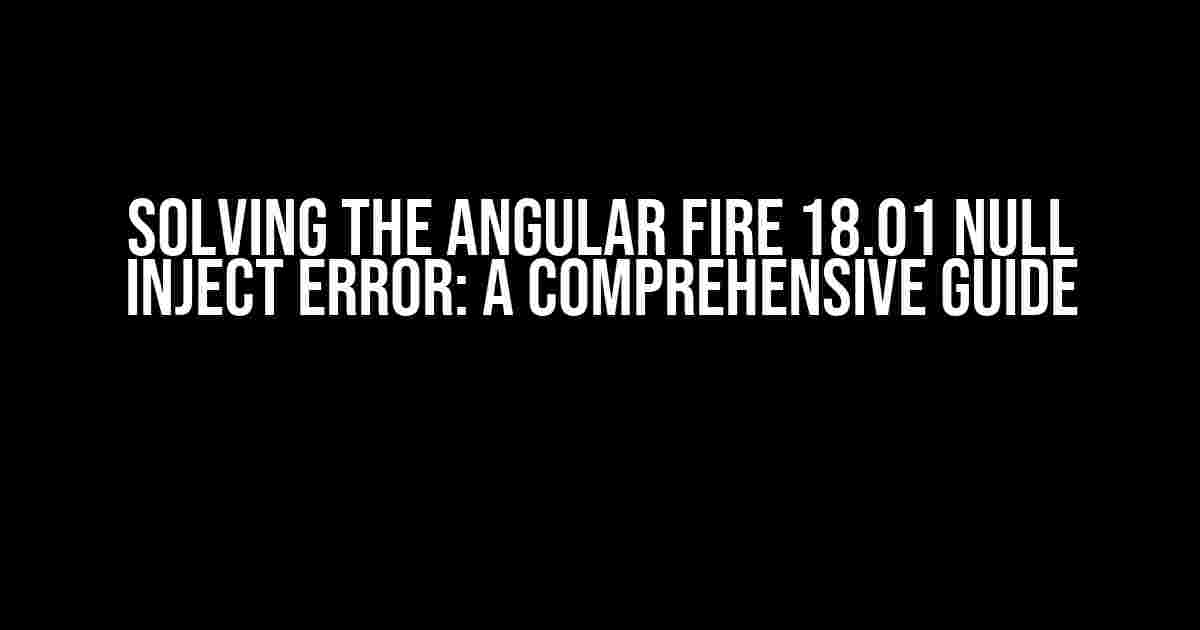Are you tired of encountering the infamous “Null Inject Error” when initializing a component in Angular Fire 18.01? Fear not, dear developer, for you’re about to embark on a journey to conquer this vexing issue once and for all!
What is the Null Inject Error, Anyway?
The Null Inject Error typically occurs when Angular’s Dependency Injection (DI) system fails to provide a required service or component to the requesting component. This can happen due to various reasons, such as:
- Misconfigured module imports
- Invalid service providers
- Incorrectly injected dependencies
- Version conflicts between Angular and Angular Fire
Identifying the Culprit: Debugging the Error
To tackle the Null Inject Error, you must first identify the root cause. Follow these steps to debug the issue:
console.log()your way to victory: Add console logs in your component’s constructor to inspect the injected services and components. This will help you pinpoint the exact location of the error.- Check the Angular DevTools: Utilize the Angular DevTools extension in your browser to inspect the component tree and identify any discrepancies in the dependency graph.
- Verify module imports: Ensure that all required modules are imported correctly in your component’s module. Double-check that the module imports are correctly configured and that there are no circular dependencies.
Solution 1: Verify Module Imports and Providers
One of the most common causes of the Null Inject Error is misconfigured module imports. To resolve this, follow these steps:
// Verify that the module is imported correctly
import { NgModule } from '@angular/core';
import { AngularFireModule } from '@angular/fire';
import { AngularFirestoreModule } from '@angular/fire/firestore';
@NgModule({
imports: [
AngularFireModule.initializeApp(environment.firebaseConfig),
AngularFirestoreModule,
],
})
export class AppModule {}
In the above example, we’ve imported the AngularFireModule and AngularFirestoreModule correctly in the AppModule. Ensure that you’ve provided the necessary Firebase configuration in the environment.firebaseConfig file.
Solution 2: Use the providedIn Syntax
In Angular 9 and later, the providedIn syntax is used to specify the injection scope for services. Update your service providers to use the providedIn syntax:
import { Injectable } from '@angular/core';
import { Firestore } from '@angular/fire/firestore';
@Injectable({
providedIn: 'root',
})
export class MyService {
constructor(private firestore: Firestore) {}
}
In this example, we’ve updated the MyService to use the providedIn: 'root' syntax, which specifies that the service should be provided at the root level.
Solution 3: Check for Version Conflicts
Angular Fire 18.01 requires a specific version of Angular. Ensure that you’re using compatible versions of both libraries:
| Angular Version | Angular Fire Version |
|---|---|
| <= 12.2.3 | <= 6.1.5 |
| >= 13.0.0 | >= 7.3.1 |
Verify that you’re using the correct versions of Angular and Angular Fire. If you’re using incompatible versions, update to the recommended versions.
Solution 4: Inject Services Correctly
When injecting services, ensure that you’re using the correct syntax and that the service is properly registered in the component’s module:
import { Component, Injectable } from '@angular/core';
import { MyService } from './my.service';
@Component({
selector: 'app-example',
template: 'Example Component
',
providers: [MyService],
})
export class ExampleComponent {
constructor(private myService: MyService) {}
}
In this example, we’ve injected the MyService correctly in the ExampleComponent. Ensure that you’ve registered the service in the component’s module using the providers array.
Conclusion
By following these steps, you should be able to identify and resolve the Null Inject Error when initializing a component in Angular Fire 18.01. Remember to debug the error, verify module imports and providers, use the providedIn syntax, check for version conflicts, and inject services correctly.
If you’re still encountering issues, don’t hesitate to reach out to the Angular Fire community or seek help from a professional developer. Happy coding!
Frequently Asked Question
Get ahead of the curve and troubleshoot like a pro with these Angular Fire 18.01 null inject error solutions!
What is the “null inject” error in Angular Fire 18.01, and why does it occur?
The “null inject” error in Angular Fire 18.01 occurs when the Angular Dependency Injection system fails to provide an instance of a service or module to a component. This can happen when the module or service is not properly imported, or when there’s a mismatch in the module versions.
How do I troubleshoot the “null inject” error in my Angular Fire 18.01 component?
To troubleshoot the “null inject” error, review your component’s constructor and ensure that all dependencies are properly imported and injected. Check the Angular Fire 18.01 documentation for the correct import statements and module configurations. You can also use the Angular DevTools to debug and inspect the component’s dependencies.
What are some common mistakes that lead to the “null inject” error in Angular Fire 18.01?
Common mistakes that lead to the “null inject” error include forgetting to import the Angular Fire module, incorrect module versions, and mismatched import statements. Additionally, not providing the correct providers or using the wrong injection tokens can also cause the error.
How do I fix the “null inject” error when initializing an Angular Fire 18.01 component?
To fix the “null inject” error, ensure that you’ve imported the Angular Fire module correctly, and that the module version matches the one in your package.json file. Verify that you’ve provided the correct providers and injection tokens in your component’s constructor.
Are there any specific Angular Fire 18.01 configuration options that can help prevent the “null inject” error?
Yes, you can use the `provideFirebaseApp` function to explicitly provide the Firebase app instance to your Angular Fire module. This can help prevent the “null inject” error by ensuring that the Firebase app instance is properly injected into your component.
